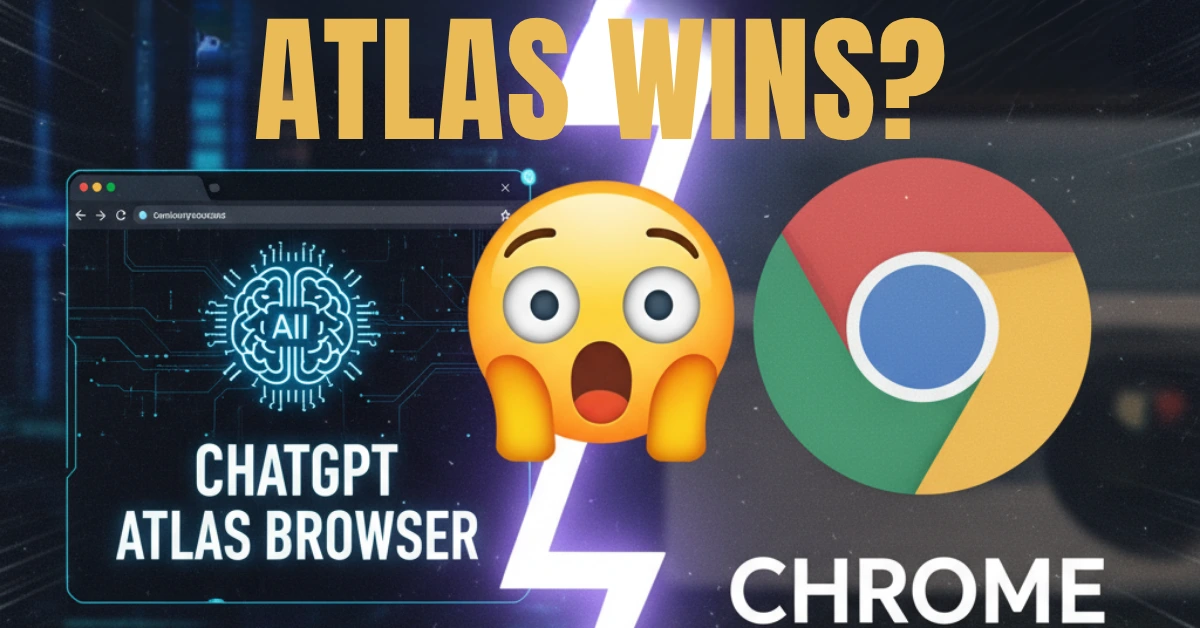Chatgpt Atlas vs Chrome is a war nowadays: If you’ve ever wished your browser could understand what you’re doing, summarize pages instantly, remember your research, and even complete tasks for you—meet ChatGPT Atlas.
Also called the atlas browser, it’s OpenAI’s bold new ChatGPT atlas web browser that fuses everyday browsing with a conversational AI assistant and an optional agent that can take action on your behalf.
Think of it as the open ai browser that turns the web into an interactive workspace rather than a pile of tabs.
What is ChatGPT Atlas?
ChatGPT Atlas is OpenAI’s next-generation OpenAI browser built around ChatGPT. Instead of hopping between chats and tabs, the ChatGPT browser merges them. Each tab can become a conversation where you ask, “Summarize this,” “Compare these,” “Find the best option,” or “Draft an email using this page.” It’s not just search—it’s guidance, memory, and action, tightly integrated into your everyday flow. If you’ve searched “ChatGPT down” during crunch time, the promise of a smarter, context-aware alternative will feel like a breath of fresh air.
Why Atlas feels different from any “open ai” browser
- ChatGPT in every tab: The chat gpt atlas experience places ChatGPT beside whatever you’re viewing. No copy-paste gymnastics—just ask right there.
- Context-aware help: The ChatGPT atlas browser reads the page you’re on and gives you relevant summaries, highlights, comparisons, and follow-ups.
- Natural language control: Type what you want like “Clean up these tabs,” “Plan a 3-day Goa itinerary,” or “Turn this product page into a pros-and-cons list.”
- Memory across sessions: With consent, OpenAI atlas can remember key topics you research, pages you revisit, and preferences—so your next session starts smarter.
- Agent Mode preview: The gpt atlas agent can perform multi-step tasks for you—compare items, fill forms, assemble itineraries, create docs—while asking permission before sensitive steps.
Who is ChatGPT Atlas for? Explore Chatgpt Atlas vs Chrome
- Researchers and students: Turn messy notes and dozens of tabs into clean summaries, citations, and drafts without breaking flow. If “googl” chaos and tab overload define your study nights, Atlas trims the noise.
- Creators and marketers: Use the ChatGPT atlas web browser to outline articles, extract insights from sources, and draft copy or briefs in-line while you browse.
- Shoppers and planners: Ask the OpenAI atlas assistant to compare products, capture specs, and build shortlists; then switch to agent mode to assemble a plan.
- Power users: If you juggle productivity tools, docs, and references, gpt chat inside the browser means less context-switching and more focus.
Key features of ChatGPT Atlas you’ll notice on day one
- Ask sidebar: A persistent chat where you can question any page, generate summaries, translate content, or reformat data without leaving your tab.
- Action prompts: Tell ChatGPT atlas to do things—extract tables, create checklists, draft emails from a page, or generate outlines.
- Smart memory: If enabled, the browser recalls your ongoing projects and nudges you with helpful continuity like “Want to continue your laptop comparison?”
- Multimodal uploads: Drag images or PDFs into the chat for instant analysis; use it as your “understand this file now” tool without opening separate apps.
- Clean UI, familiar core: It behaves like a modern browser with tabs, bookmarks, and profiles—just infused with ChatGPT’s intelligence at every step.
Privacy and control: Chatgpt Atlas vs Chrome
- Opt-in memory: Browser memory is optional and transparent. You decide what’s remembered, what’s forgotten, and when to use private/incognito sessions.
- Explicit approvals: Agent actions that touch accounts, payments, or personal data require your confirmation.
- Data usage: You control whether activity contributes to model improvement; defaults prioritize user privacy.
How Chatgpt Atlas vs Chrome compares to your current setup?
- Versus traditional browsers: Instead of treating the web like static pages and bookmarks, ChatGPT atlas turns it into a living workspace—summaries, comparisons, and drafts appear alongside the content.
- Versus extensions: You don’t need a patchwork of plugins. The open ai atlas approach builds the assistant into the core flow, which reduces friction and improves context understanding.
- Versus AI sidebars elsewhere: Deep integration means less copy-paste, better page awareness, and smoother “ask-then-act” workflows.
Potential downsides to consider
- Learning curve: Switching from search-first to conversation-first browsing takes a few days to click.
- Over-reliance risk: Like any AI, it can occasionally misinterpret content. For critical tasks, verify sources and cross-check outputs.
- Agent limits: Agent Mode is evolving; complex automations may still need guidance. Treat it as a capable co-pilot, not a fully autonomous assistant.
Practical use cases of ChatGPT Atlas you can try
- “Summarize this 3,000-word review into a comparison table with pros/cons.”
- “Extract the top 5 specs and prices from these product pages and rank by value.”
- “Turn this article into a LinkedIn post and a 30-second script.”
- “Plan a weekend trip under ₹30,000 with flights, hotels, and food suggestions.”
- “Draft an email response using the tone from this webpage.”
- “Audit these tabs and group them by project, then close duplicates.”
| Homepage | www.sarkarijobfeed.com |
In Short: Chatgpt Atlas vs Chrome
ChatGPT Atlas is the first browser that truly treats the web as a conversation. If you’ve felt the pain of endless tabs, copy-pasting into AI, or scrambling when ChatGPT is down, this is the OpenAI atlas moment: a smarter, memory-aware, agent-capable browser that helps you research, write, plan, and act—in one place.
